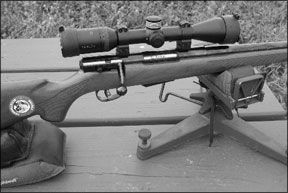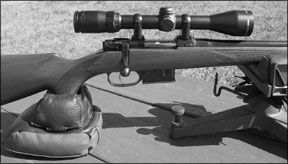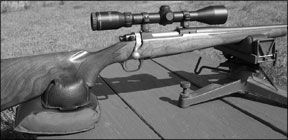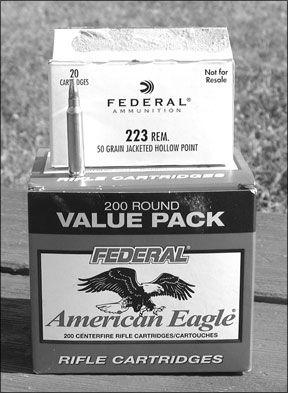The 223 Remington is a practical cartridge with broad appeal and application. It has already been some 44 years since the U.S. Army adopted it, based on the 222 Remington that itself was quite a commercial success since its 1950 introduction. Like most cartridges or variants adopted by the military, its long-term popularity is virtually guaranteed. It is one of our favorite cartridges, with a variety of ammunition available at reasonable prices. Unlike some of the older “burn a lot of powder in a small hole” rounds such as the 220 Swift, or perhaps the more recent 204 Ruger, the 223 Remington offers generally good barrel life and overall economy that makes it a fabulous choice for many as a general-purpose 22-caliber centerfire.

Likewise, the 223 comes chambered in a wide selection of rifle styles, and for this test, we have selected three rifles with sporter-profile barrels and lighter, handier overall dimensions compared to heavy-barrel varmint rifles. Our test guns are the types of reliable, fun rifles that are ideal for coyote and other predator hunting where mobility is required. Call them ranch rifles, coyote rifles, long-range groundhog guns, walking varminters, or even whitetail rifles in some areas-they have tremendous utility and flexibility, easy on shoulder and wallet alike. The contestants are the CZ USA 527 American 03022, $711; Ruger HM77R Hawkeye 07103, $779; and the Savage Model 25 Classic Sporter, $616.
Bob Forkers Ammo & Ballistics II lists about 67 different factory 223 Remington loads, and thats just scratching the surface-not counting custom ammo, the tremendous number of reloading recipes, and the new variants introduced annually. We wanted to compare results with reasonably priced, “non-match” ammo-but we didnt want to go the route of various one-off bulk buys or surplus ammo, either. In times past, South African battle-pack military surplus 5.56mm rounds and Israel Military Industries (IMI) cartridges have both given unimpressive results, so we dont feel the “just making brass” class of ammo is worth the bother these days. SAAMI warned against the use of 5.56mm ammunition in 223 Remington chambered rifles back in January 1979. We believe in erring on the side of caution and safety; therefore, the ammunition we test will have a headstamp that matches the barrels of our rifles.
Over the years, we have found that Federal American Eagle 50-grain jacketed hollowpoints have given us surprisingly good performance considering the price tag. Here, we tested Federal load #AE223G; in the pile of 200-round bulk packs we bought it is #AEBP223G. This 50-grain hollowpoint is a 3400 fps MV load, with a published G1 ballistic coefficient of .204. It was this load we decided to use as a baseline for the bulk of our testing. We also shot a five-shot strings under just adequate range conditions (89 degrees F., 10-15 mph pulsing crosswind) as fast as possible, letting the groups stand as they were shot: no discarding “flyers” or any artificial skewing of the results. This is the type of shooting we feel is relevant to “minute-of-coyote” field performance. Further, we fired three-shot accuracy groups at 100 yards from bag and cradle, testing Stars & Stripes Custom Ammunition 40-grain Barnes Varminator rounds, Remington-UMC 45-grain jacketed hollowpoints, and again with our Federal American Eagle 50-grain rounds.

To record velocities, we used a Competitive Edge Dynamics CED M2 Chronograph set 15 feet from the muzzle, and the shooting was done at a range 500 feet above sea level, with air temperatures around 77 degrees. We shot the CZ 527 in set trigger mode for this portion because we found it resulted in tighter groups than the standard trigger pull. In all the firing, we had only one hang-up; a failure to feed a Remington-UMC round from the clip of the CZ.
CZ USA 527 American 03022 223 Rem., $711
A couple of comments about “Manufacturers Suggested Retail Prices”: We naturally think it is important to give the consumer realistic barometers for comparison. Over the last couple of years, though, pricing has not been consistent with dollar/Euro considerations and mid-year price increases. In 2006, the MSRP for this rifle was $599, while CZ currently calls it $711 retail on the company website that does not appear to have been changed since 2007. It is listed at $896 with the “fancy American walnut stock.” The 527 M1 model has a three-round detachable magazine and

different trigger guard, but it is fundamentally the same rifle-also listed at $711. Nevertheless, we have seen them listed at a bit over retail of late, so consider these numbers a vague guide.
The CZs hammer-forged barrel was coated with a semi-matte blue and had a 1:12-rate-of-twist rifling-considered ideal for 55-grain bullets, but less so for the heavier options. The checkered walnut stock had straight grain, but we thought it was still pleasing to the eye with a warm chestnut medium-dark stain.
The CZ “Micro-Mauser” action featured a single set trigger, an addition our shooters loved. In conventional mode the trigger broke at a reasonably crisp 4 pounds. After being set, the trigger broke at 1.4 pounds. The CZ came with a five-round stamped-steel detachable magazine. In a couple of instances, the fifth round caused a little binding when we tried to close the bolt, but when using the factory five-round as a four-round magazine, we never had a suspicion of a hang-up.
The safety is noisy compared to the Savage, requiring the shooter to pull it back rather than forward to release it. As you might expect, the ejection of spent brass is contingent bolt-speed as you would expect on most wing-type ejectors-pull back very slowly, and the empty brass can eject weakly enough to fall right back into the loading port.
CZ supplies BRNO rings with its 527s, but we felt that the rings should have been more substantial-so we didnt bother to fight with them. The dovetail scope-mounting bases (16mm) are integral with the receiver, so all you need are rings.
We found that some medium rings were too short to allow the bolt to clear the ocular end of several scopes we attempted to mount, so we bought a pair of Burris CZ527 medium-height black steel rings, Burris #420140, which did not have this issue. With a Bushnell Elite 3200 3-9x40mm scope, the Burris rings allowed the bolt to clear the scope, but just barely. The bolt cleared the scope, but not when the factory scope covers were on. With scope mounted, the diminutive CZ 527 weighed right at 7.5 pounds.
At the range, using the Stars & Stripes 40-grain Barnes Varminator hollowpoints, the CZ printed 0.5-inch groups on average, better than the Savages 0.7-inch average groups and a 1.6-inch average from the Ruger. The CZ came in second shooting the Remington UMC 45-grain jacketed hollowpoints, a tenth of an inch (1.5 inches) behind the Ruger (1.4 inches) and slightly better than the Savage (1.6 inches). With the third ammo, Federal American Eagle 50-grain jacketed hollowpoints, the CZ tied the Savage with eye-popping 0.5-inch group averages, substantially better than the Rugers 1.1-inch average group size. All of the tested rifles were creampuffs to shoot, with a little bit of muzzle flip present on the CZ American
Ruger HM77R Hawkeye 07103 223 Rem., $779
If we graded the Ruger Hawkeye all by itself, it would have easily gained the consensus of being a nice rifle. It didnt though, suffering by comparison. This illuminates the value of head-to-head comparisons with a critical eye rather than testing in a vacuum.
For example, this M77 Hawkeye featured Rugers new, improved “LC6” trigger-standing for “Light and Crisp.” Well, it was not a bad trigger, and it had no discernible take-up, so we can go along with the “crisp” designation. It broke at 4.7 pounds, by far the heaviest of the tested rifles. The Savage AccuTrigger put it to shame, and so did the CZ trigger in both standard and set-trigger modes. Not bad, not awful, but also clearly inferior to both the Savage and the CZ.
Aesthetically, the Ruger was pleasing to the eye. The Rugers stock was easily the best grade of walnut of all the rifles, with distinctive grain and mineral streaks. The red-rubber butt pad, touted to “absorb the most punishing recoil,” seemingly was capable of nothing special in that department, but it looked classy. We were ambivalent about the Rugers matte blue finish. It was evenly, nicely applied-but the Ruger highly polished blue has generally been excellent.
There was some attention to detail, though. The action appeared to be the well-known K77MKII Mauser variant, with a nicely turned bolt handle for good scope clearance. We mounted a Burris Signature Select 3-10x40mm scope to the Ruger, using the supplied Ruger medium integral rings with no hassle. Unlike the CZ attempt, we have absolute confidence in the Ruger rings. We also appreciated that the rings come with hex-head caps, not the old flat-blade screwdriver slots that were a hassle in the past.
The Ruger had a hinged floorplate and integral magazine, and the floor plate and Ruger trigger guard were nicely done. At first blush, with better lines than the blockish CZ, much nicer wood, and supplied integral rings, you might think the Ruger was well on its way to winning the comparison. So did we, until we started shooting it.
It quickly became obvious that the Ruger is sluggishly heavy and ponderous compared to either the CZ or the Savage, had a trigger than did not compare well, and was not in the same league in the

accuracy department, as we noted above in the CZ section. The Ruger, as tested, was roughly a 1.5-MOA rifle. Where both the Savage and the Mauser had nicely floated barrels, there was no attempt at that with the Ruger-essentially full wood contact all the way to the action. Some folks might feel that 1.75-inch groups are okay with bulk ammo and a light barrel, but not when the goal is to place a shot into the center of a coyotes 5-inch kill zone at 250 yards. We tried a few other types of custom and premium ammo to see if the Ruger would suddenly come alive for us, but to no avail. We never did get it to the MOA 100-yard arena, where the CZ and the Savage had no problem grouping far tighter than that.
At the end of the day, despite the Rugers strong action, attention to build detail, nice wood, rings, and clean lines-we unanimously decided that the other guns were better.
Savage Model 25 Classic Sporter 223 Rem., $616
New for 2008, Savage has built upon its experience with the .22 Hornet-only Model 40, its beautifully done Classic centerfire line, along with its hugely successful rimfire rifles, and cooked up a new rifle. At a glance, the Model 25 looks like the big brother to Savages 93R17 Classic 17 HMR. Looking closer, it is a lot more than that.
This is a brand-new action from Savage, stemming from neither the Model 40 nor the companys revered short action. The Model 25 has a solid bolt, no floating bolt head, and has three generous locking lugs at the front that make it more than suitably robust for this application. It is a more compact, lighter action with a threaded and pinned barrel array, including a recoil lug that, though not the familiar Savage “switch barrel,” allows this gun to be lighter and livelier than possible before.
Cosmetically, our test sample shared some of the refinements we have come to expect in Savages Classic line: walnut stock with cut checkering, a black fore end tip, a flashy jeweled bolt, a grip cap, and highly polished blueing. Like the well-known Savage short actions, the barrel was nicely floated and secured with dual pillars. Overall, it was a downsized action well suited to the chamberings it is offered in: 204 Ruger and the 223 Remington. It retained the Accu-trigger, with a two-position thumb safety at the right of the action.
This Savage Accu-trigger broke at 2.7 pounds right out of the box. It felt so good we didnt bother to adjust it further. It is a far better trigger than the Rugers, and clearly better than the CZs standard trigger pull, in our opinion.
The magazine set-up appeared to be an all-new array, with the magazine well and the trigger guard formed as a one-piece plastic fixture, which we thought was both aesthetically pleasing and well fitted. Savage supplied a new magazine, also plastic, that accompanied the Model 25. It had a four-shot capacity, loaded and fed like a dream, and fit its mating surfaces well with no rattling. It is best described as a structural polymer, rather than the vague “plastic.” It was light weight, wouldnt be prone to corrosion, and wasnt hard on the eyes.
The Savage came supplied with Weaver bases already installed-a thoughtful touch. We used Warne steel permanent rings to attach a Kahles CL 3-9x42mm riflescope. With the 60-degree bolt lift of the Savage, scope mounting was a breeze. The Savage was a tad heavier than the CZ at 7.15 pounds unscoped, and was noticeably lighter and quicker handling than the Ruger.
The Savage shot superbly right out of the box; when we flinched just right, we were able to touch holes. The Model 25 is an MOA gun with bulk American Eagle ammo, and half-MOA with the right ammo. We really had no great debate over what gun was the most accurate; we concluded that as a practical matter both the Savage Model 25 and the CZ could place bullets far more precisely than we could in field hunting conditions. The difference of group size either way came down to specific ammo for individual rifle.
Both the Savage Model 25 and the CZ 527 American were outstanding rifles, with accuracy in the arena of some dedicated varmint rifles rather than the light, fast-handling guns that they are. It was easy to put a scope on the Savage Model 25, shot all the rounds we put into the detachable magazine with no snags, ejected brass well, regardless of bolt speed, and its safety was far more quiet than the CZs push-forward safety. The lines of the Savage were less blocky than the CZs, and the grip cap, jeweled bolt, and closer-to-flush-mount magazine made the Savages lines better. We also liked the ability to easily feed a single cartridge into the Savage, rather than rely on a strip from a clip as in the Mauser-esque actions of the CZ or Ruger. The Savage action, we felt, was more appropriate for both the cartridge and general use.
1008-VARMINT-RIFLE-ACCURACY.pdf




























